AMD Radeon HD 7970 Review: 28nm And Graphics Core Next, Together As One
by Ryan Smith on December 22, 2011 12:00 AM EST- Posted in
- GPUs
- AMD
- Radeon
- ATI
- Radeon HD 7000
Crysis: Warhead
Kicking things off as always is Crysis: Warhead. It’s no longer the toughest game in our benchmark suite, but it’s still a technically complex game that has proven to be a very consistent benchmark. Thus even 4 years since the release of the original Crysis, “but can it run Crysis?” is still an important question, and the answer continues to be “no.” While we’re closer than ever, full Enthusiast settings at a 60fps is still beyond the grasp of a single-GPU card.
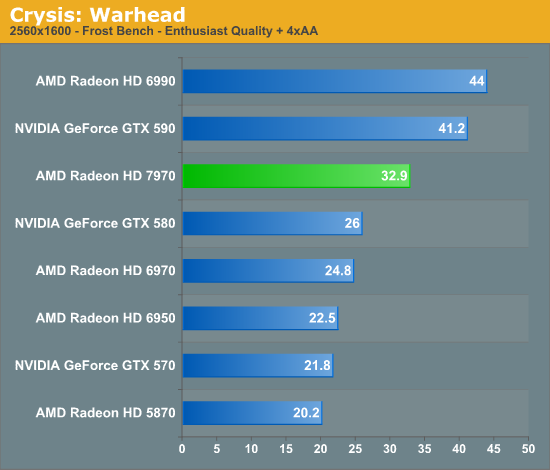

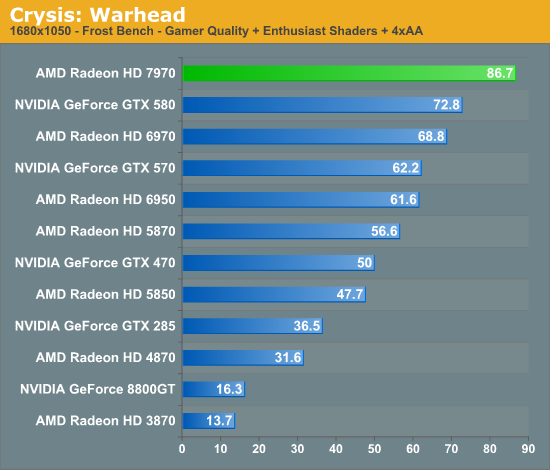
This year we’ve finally cranked our settings up to full Enthusiast quality for 2560 and 1920, so we can finally see where the bar lies. To that extent the 7970 is closer than any single-GPU card before as we’d imagine, but it’s going to take one more jump (~20%) to finally break 60fps at 1920.
Looking at the 7970 relative to other cards, there are a few specific points to look at; the GTX 580 is of course its closest competitor, but we can also see how it does compared to AMD’s previous leader, the 6970, and how far we’ve come compared to DX10 generation cards.
One thing that’s clear from the start is that the tendency for leads to scale with the resolution tested still stands. At 2560 the 7970 enjoys a 26% lead over the GTX 580, but at 1920 that’s only a 20% lead and it shrinks just a bit more to 19% at 1680. Even compared to the 6970 that trend holds, as a 32% lead is reduced to 28% and then 26%. If the 7970 needs high resolutions to really stretch its legs that will be good news for Eyefinity users, but given that most gamers are still on a single monitor it may leave AMD closer to 40nm products in performance than they’d like.
Speaking of 40nm products, both of our dual-GPU entries, the Radeon HD 6990 and GeForce GTX 590 are enjoying lofty leads over the 7970 even with the advantage of its smaller fabrication process. To catch up to those dual-GPU cards from the 6970 would require a 70%+ increase in performance, and even with a full node difference it’s clear that this is not going to happen. Not that it’s completely out of reach for the 7970 once you start looking at overclocking, but the reduction in power usage when moving from TSMC 40nm to 28nm isn’t nearly large enough to make that happen while maintaining the 6970’s power envelope. Dual-GPU owners will continue to enjoy a comfortable lead over even the 7970 for the time being, but with the 7970 being built on a 28nm process the power/temp tradeoff for those cards is even greater compared to 40nm products.
Meanwhile it’s interesting to note just how much progress we’ve made since the DX10 generation though; at 1920 the 7970 is 130% faster than the GTX 285 and 170% faster than the Radeon HD 4870. Existing users who skip a generation are a huge market for AMD and NVIDIA, and with this kind of performance they’re in a good position to finally convince those users to make the jump to DX11.
Finally it should be noted that Crysis is often a good benchmark for predicting overall performance trends, and as you will see it hasn’t let us down here. How well the 7970 performs relative to its competition will depend on the specific game, but 20-25% isn’t too far off from reality.
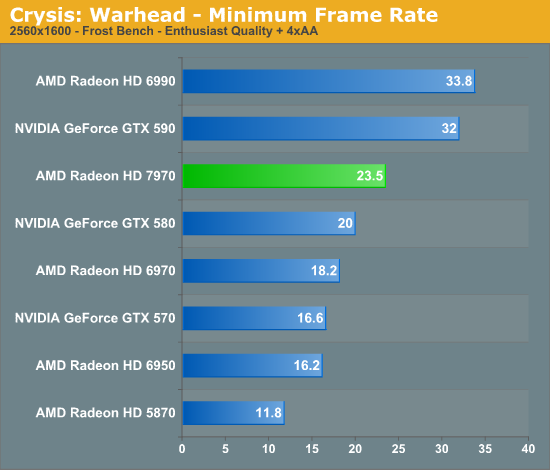
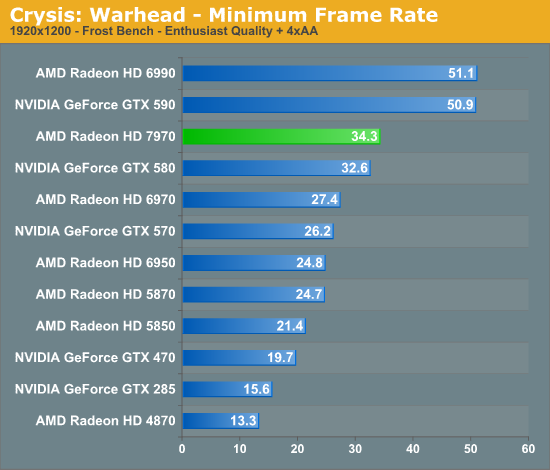
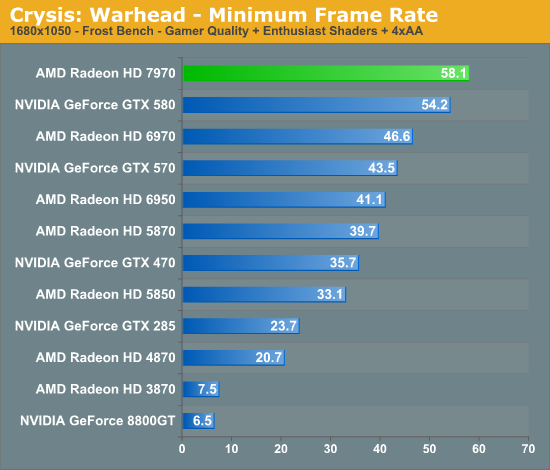
Looking at our minimum framerates it’s a bit surprising to see that while the 7970 has a clear lead when it comes to average framerates the minimums are only significantly better at 2560. At that resolution the lowest framerate for the 7970 is 23.5 versus 20 for the GTX 580, but at 1920 that becomes a 2fps, 5% difference. It’s not that the 7970 was any less smooth in playing Crysis, but in those few critical moments it looks to be dipping a bit more than the GTX 580.
Compared to the 6970 on the other hand the minimum framerate difference is much larger and much more consistent. At 2560 the 7970’s minimums are 29% better, and even at lower resolutions it holds at around 25%. Clearly even with AMD’s new architecture their designs still inherit some of the traits of their old designs.










292 Comments
View All Comments
CeriseCogburn - Thursday, March 8, 2012 - link
The gentleman should get one of the high end cards, and run on the common 19x0 x 1xxx monitors that poor people have several of nowadays, then crank up a decent 3d game and get back to us.These cards are not as powerful as the naysayers think - there's a lot of SUCK left in them even in cheap setups, let alone high end everything X2 or X4.
Ph0b0s - Thursday, December 22, 2011 - link
This was one of the most interesting parts of the article. So the only thing that requires new hardware is "Target Independent Rasterization". What does that do, so we know how much we are missing out on from only having Directx 11 hardware.SlyNine - Thursday, December 22, 2011 - link
Second that.Sgt. Stinger - Thursday, December 22, 2011 - link
I would like to call attention to that the reviewer at www.sweclockers.com noticed a full 10° C temperature drop on full load after removing and re-mounting the cards cooler with a quality thermal paste. This is quite significant, and the card should be more quiet after doing this.Chloiber - Thursday, December 22, 2011 - link
Computerbase noticed the exact same thing. They said, that AMD even told them, that there was a problem with the thermal paste (that's why they tested it specifically).It's still as loud as a GTX590 with new thermal paste though... :>
Sgt. Stinger - Thursday, December 22, 2011 - link
Well, yes, unless you can use custom fan profiles. I hope it is possible at least via third party software.If not, the cheapest way to get a reference cooler quiet is to remove the shroud and original fan, and strap on a couple of 120mm fans :D
Ryan Smith - Thursday, December 22, 2011 - link
This is the first I've heard of this. I've pinged AMD, but if they believed it was a problem for us I expect we would have heard about it by now.Sgt. Stinger - Friday, December 23, 2011 - link
Well, maybe, but your load temps seem to correspond to sweclockers load temps as they were before re-mounting the cooler. (here's their temp graph, before: http://www.sweclockers.com/image/diagram/2621?k=3f... ) and after remounting they got 66° C instead.SlyNine - Friday, December 23, 2011 - link
Honestly I'd rather have these benchmarks now than have the benchmarks cut any shorter becuase he had to remount the fan.Worth looking in to moving forward though.
CeriseCogburn - Thursday, March 8, 2012 - link
Oh, so another amd defect in released cards problem... so did we ever get the same treatment for the 480 or the 470 or the 580 or the 570 ?NO !
Of course not silly rabbit, screw nvidia and excuse amd and blame anything and anyone but.....
Thank you this is hilarious...